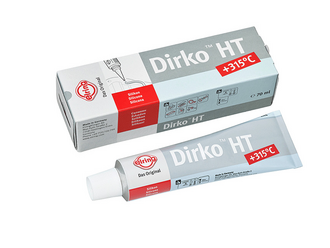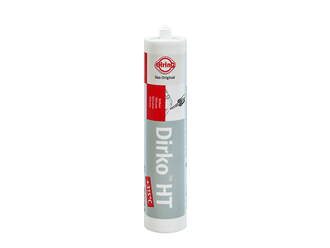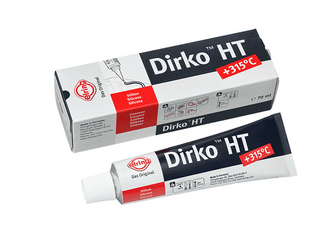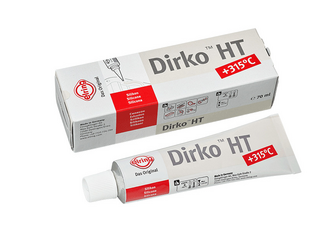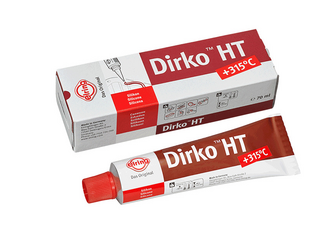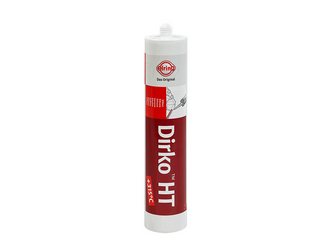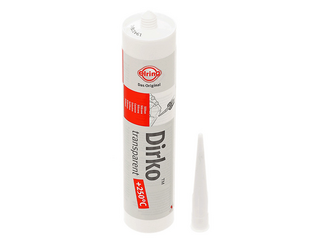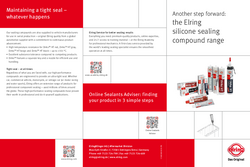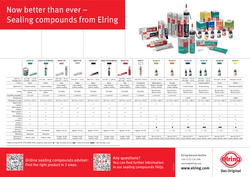Our sealing compounds are also supplied to vehicle manufacturers for use in serial production – original Elring quality from a global automotive supplier with a commitment to continuous product advancement.
• High temperature resistance for DirkoTM HT red, DirkoTM HT gray, DirkoTM HT beige and DirkoTM HT black – up to +315 °C.
• Excellent substance tolerance compared to competing products.
• DirkoTM features a squeeze key and a nozzle for efficient use and handling.
With the exception of Dirko HT ProfiPress, all Dirko products can be shipped via air freight. Dirko HT ProfiPress can not be shipped via air freight due to the pressure gas can.
No. Dirko is not subject to registration obligations (REACH, SCIP) in the sense of listed substances of concern (SVHC) of the European institution ECHA.
Dirko is resistant to mineral oils (including additives), synthetic oils, lubricating grease, coolants, UV radiation, cold and hot water, salt water, cleaning agents, weak acids and alkalis.
The technical properties are practically identical and only differ in colour. The temperature range of Dirko transparent is slightly lower compared with Dirko HT products. Other technical properties can be found in the technical data sheet.
Yes. The crosslinking of the Dirko sealant is activated by taking in humidity from the air. With an ambient temperature of 23°C and a relative humidity of 50%, a curing time of 2mm in 24h can be assumed.
No. Dirko is resistant to mineral oils (including additives), synthetic oils, lubricating grease, coolants, UV radiation, cold and hot water, salt water, cleaning agents, weak acids and alkalis.
No. Dirko is unfortunately not resistant to fuel. For use with contact with fuels, we recommend our sealants Curil T2 or El-Liq 73 and El-Liq 74.
Yes. Dirko is not subject to registration obligations (REACH, SCIP) in the sense of listed substances (SVHC) of the European institution ECHA.
Details on the shelf life in unopened state are found in the technical data sheet. The direct product packaging contains the date of bottling in the form of a numerical code with the coding YYWWBBBB (year, week, batch number). A usable sealant can be removed from the packaging in liquid form and forms a skin on the surface after approx. 15 minutes. Otherwise, crosslinking and correct function are not guaranteed.
In principle, yes. Dirko adheres extremely well on paper surfaces. A combination of a paper seal and silicone sealant should definitely be looked in to though.
No, Dirko is currently not certified for use in food areas.
Sealing from the outside is possible, but is not ideal. On a clean, grease-free material surface made of metal, cast iron, plastic PA, glass, paper, Dirko has very good adhesive properties. Ideally, however, Dirko should be used in a sealing gap for sealing. Application on a sealing gap with simultaneous pressure application from the inside can cause sealing problems, however.
In principle, yes. Dirko products offer outstanding adhesion on the material surfaces metal, cast iron, plastic PA (polyamide), glass and paper. A combination of a seal and sealant should always be looked in to though.
A usable sealant can be removed from the packaging and forms a skin on the surface after approx. 15 minutes. Otherwise, crosslinking and correct function are not adequately guaranteed. No guarantee can be provided once the use by date has passed.
Yes, wet installation is possible with Dirko products. Waiting for the skin to form, however, means that the parts can be loosened from each other more easily during disassembly at a later stage.
Silicone-based sealants are ideal for a high gap filling capacity of up to 2.00mm. On the material surfaces metal, cast iron, plastic PA (polyamide), glass and paper, Dirko products offer outstanding adhesion and crosslink with the help of the ambient air (humidity) to create a permanently elastic seal. Other technical properties can be found in the technical data sheet.
Different colours are available depending on the customer wishes or the manufacturer-dependent installation situation. Otherwise, the technical properties are almost identical. The temperature range of Dirko HT red/black/grey/beige is -60°C to +315°C. The temperature range of Dirko transparent is slightly lower at -60°C to +250°C. Other technical properties can be found in the technical data sheet.
The chemical crosslinking of Dirko HT red is based on vinegar. This is why Dirko HT red has a slight odour of vinegar on contact with air. All other Dirko products are based on a OXIM crosslinking. This is why they have no vinegar odour. All technical properties of the Dirko products can be found in the technical data sheet.
Dirko HT ProfiPress is a 200 ml compressed gas cartridge with nozzle. The compressed gas and the adjustable opening mechanism enable an extremely even sealing bead to be applied on the surface. It is even possible to apply the sealant "over head", e.g. in an installation pit, with Dirko HT ProfiPress. Other technical properties can be found in the technical data sheet.
Once the sealing point has been created, wait approx. 30 minutes for a functioning seal to form. Oil can then be poured into an oil sump again, for example. After 5-15 minutes (depending on the humidity and heat in the ambient air), a skin will develop on the surface. Waiting for the skin to form means that the parts can be loosened from each other more easily during disassembly at a later stage.
Dirko is particularly suited for gap sealing and can seal sealing gaps of up to 2.00 mm. Further information on media resistance, suitable surface materials and possible usage areas can be found in the technical data sheet.
Details on the shelf life in unopened state are found in the technical data sheet. The direct product packaging contains the date of bottling in the form of a numerical code with the coding YYWWBBBB (year, week, batch number).
Coarse residues can be removed effectively with a scraper (plastic) or a brush (brass / bristle disc). Finer residues should be removed with a cloth and ideally with isopropyl (isopropyl alcohol) or brake cleaner.
The components are loosened via lever force.
First remove residues of the old sealant from the surface. Coarse residues can be removed effectively with a scraper (plastic) or a brush (brass / bristle disc). Finer residues should be removed with a cloth and ideally with isopropyl (isopropyl alcohol) or brake cleaner.
Details on the shelf life are found in the technical data sheet. The direct product packaging contains the date of bottling in the form of a numerical code with the coding YYWWBBBB (year, week, batch number).
![[Translate to Englisch:] [Translate to Englisch:]](/CELUM/10008/14310/Neuaufnahme_rot.jpg)
![[Translate to Englisch:] [Translate to Englisch:]](/CELUM/10008/14310/ZKS_rot.jpg)
![[Translate to Englisch:] [Translate to Englisch:]](/CELUM/10008/14310/SORK_rot.jpg)
![[Translate to Englisch:] [Translate to Englisch:]](/CELUM/10008/14310/ZKDS_rot.jpg)

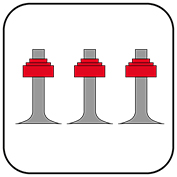
![[Translate to Englisch:] [Translate to Englisch:]](/CELUM/10008/14310/PLAT_rot.jpg)
![[Translate to Englisch:] [Translate to Englisch:]](/CELUM/10008/14310/ZKD_rot.jpg)
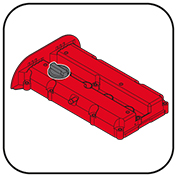

![[Translate to Englisch:] [Translate to Englisch:]](/CELUM/10008/14310/DIMA_rot.jpg)
![[Translate to Englisch:] [Translate to Englisch:]](/CELUM/10008/14310/COIL_rot.jpg)
![[Translate to Englisch:] [Translate to Englisch:]](/CELUM/10008/14310/Spezialdichtungen_rot.jpg)
![[Translate to Englisch:] [Translate to Englisch:]](/CELUM/10008/14310/DIRI_rot.jpg)
![[Translate to Englisch:] [Translate to Englisch:]](/CELUM/10008/14310/Sonderanfertigungen_rot.jpg)


